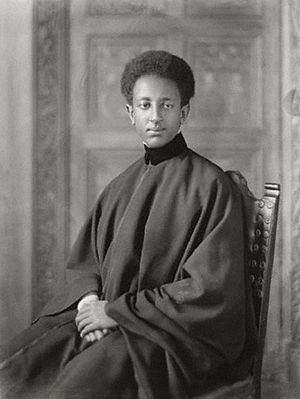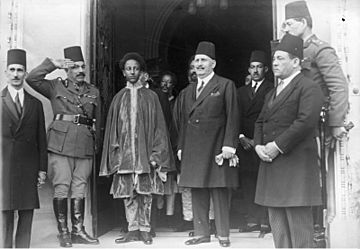Amha Selassie facts for kids
Quick facts for kids Amha Selassie |
|
|---|---|

Amha Selassie in 1932
|
|
| Emperor of Ethiopia (designate, unacknowledged) |
|
| Reign | 12 September 1974 – 12 March 1975 |
| Predecessor | Haile Selassie I as Emperor of Ethiopia |
| Successor | Monarchy abolished Tafari Benti as Chairman of the Derg |
| Chairman De facto |
Aman Andom Tafari Benti |
| Emperor-in-exile of Ethiopia | |
| Reign | 8 April 1989 – 17 January 1997 |
| Predecessor | Haile Selassie I |
| Heir-apparent | Crown Prince Zera Yacob |
| Born | 27 July 1916 Harar, Ethiopian Empire |
| Died | 17 January 1997 (aged 80) McLean, Virginia, United States |
| Burial | Holy Trinity Cathedral, Addis Ababa |
| Spouse | Wolete Israel Seyoum Medferiashwork Abebe |
| Issue | Princess Ijigayehu Princess Maryam Senna Princess Sehin Azebe Princess Sifrash Bizu Crown Prince Zera Yacob |
| House | House of Solomon |
| Father | Haile Selassie I |
| Mother | Menen Asfaw |
| Religion | Ethiopian Orthodox Tewahedo |
Amha Selassie (born Asfaw Wossen Tafari; 27 July 1916 – 17 January 1997) was the last Emperor of Ethiopia, though he ruled only in name and later in exile. He was the son of Emperor Haile Selassie I.
Amha Selassie was declared Emperor three times during his life. The first time was during a failed attempt to overthrow his father in 1960. He was forced to accept the title then. Later, in 1974, after his father was removed from power, he was again declared Emperor by a military group called the Derg. However, he never accepted this. Finally, in 1989, he was proclaimed Emperor while living in exile, and this time he accepted the title. His full royal name was His Imperial Majesty Emperor Amha Selassie I, Elect of God, Conquering Lion of the Tribe of Judah and King of Kings of Ethiopia.
Contents
Early Life and Family
Amha Selassie was born Asfaw Wossen Tafari in the city of Harar on 27 July 1916. His father was Dejazmach Tafari Makonnen, who later became Emperor of Ethiopia. His mother was Menen Asfaw.
When his father became Emperor in 1930, Asfaw Wossen became the Crown Prince of Ethiopia. He was given the title Meridazmach and was made ruler of the province of Wollo.
He first married Princess Wolete Israel Seyoum. They had one daughter, Princess Ijigayehu. When Italy invaded Ethiopia in 1936, the Crown Prince and his family went into exile. He and Princess Wolete Israel divorced in 1941.

After his father returned to power in 1941, the Crown Prince also came back to Ethiopia. He helped fight the Italian forces. He later married Princess Medferiashwork Abebe. They had three more daughters and a son, Prince Zera Yacob.
The 1960 Coup Attempt
In December 1960, while Emperor Haile Selassie was visiting Brazil, a military group tried to take over the government. The leaders of this attempt held Crown Prince Asfaw Wossen in the Imperial Palace. They forced him to announce on the radio that he was taking his father's place as Emperor.
However, the regular army fought back. The head of the Ethiopian Orthodox Church also spoke out against the rebels. The rebels were defeated and fled the capital. Before they left, they killed many government officials and nobles.
Even though it was clear the Crown Prince had been forced, some people still suspected he might have supported the coup. His wife, Medferiashwork Abebe, was praised for working against the coup attempt.
In late 1972, at age 56, Crown Prince Asfaw Wossen had a serious stroke. He was taken to London and Switzerland for medical care. The stroke left him partly paralyzed and affected his speech. Because he was so ill, his son, Prince Zera Yacob, was named "Acting Crown Prince."
Brief Period as "King"
In September 1974, a military group called the Derg removed Emperor Haile Selassie from power. They declared that Crown Prince Amha Selassie would become "King" when he returned from his medical treatment. However, Amha Selassie was still out of the country and never accepted this title or his father's removal.
When the new government carried out harsh actions against former officials, Crown Prince Asfaw Wossen strongly spoke out against them. He made his statement using his title "Crown Prince," showing he did not accept the Derg's declaration of him as monarch. He continued to use the title of Crown Prince during his exile.
The Derg officially ended the monarchy in March 1975.
Life in Exile
After the monarchy was abolished, Crown Prince Asfaw Wossen settled in London. Other members of the Imperial family who were still in Ethiopia were imprisoned. This included his father, Emperor Haile Selassie, and his daughter, Princess Ijigayehu. Both his father and his daughter died while in prison. Many other family members remained imprisoned until the late 1980s.
In April 1989, members of the exiled Ethiopian community in London proclaimed Crown Prince Asfaw Wossen as "Emperor of Ethiopia" in exile. He took the throne name Amha Selassie I. His wife also began using the title "Empress." A year later, they moved to McLean, Virginia, USA, to be closer to the large Ethiopian community there.
In 1991, the Derg government fell in Ethiopia. Amha Selassie then started a movement called Moa Anbessa to support bringing the monarchy back to Ethiopia. He wanted to visit his home country. However, a disagreement arose between the Imperial family and the new government about a state funeral for Emperor Haile Selassie. The government refused to give him a state funeral, so Amha Selassie's return was postponed.
Death
Amha Selassie passed away on 17 January 1997, at the age of 80, in Virginia, USA. He had never fully recovered from his stroke in 1972.
His body was flown back to Ethiopia and buried in the Imperial family tombs at Holy Trinity Cathedral in Addis Ababa. A large funeral ceremony was held there.
Honours
Amha Selassie received many awards and honours from Ethiopia and other countries around the world during his lifetime.
Images for kids
See Also


